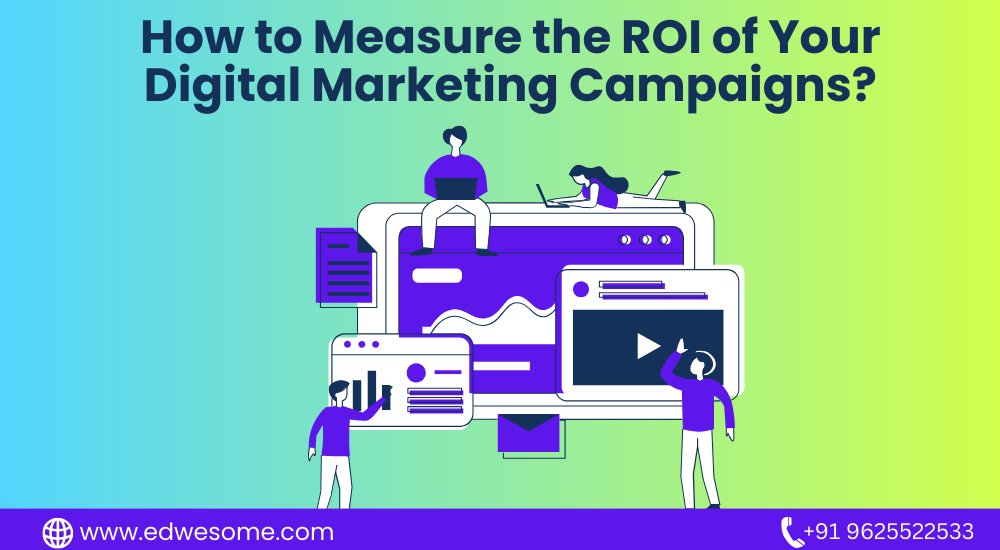In today’s digital age, businesses of all sizes are investing heavily in digital marketing campaigns to reach their target audience, generate leads, and drive sales. However, with so many different digital marketing channels and strategies available, it can be challenging to determine which ones are delivering a positive return on investment (ROI).To make well-informed choices and enhance the efficiency of your marketing endeavors, it is essential to grasp the effective methods for gauging the ROI of your digital marketing campaigns.
In this comprehensive guide, we will walk you through the process of measuring the ROI of your digital marketing campaigns step by step. By the end of this article, you will have a clear understanding of the key metrics, tools, and strategies needed to assess the success of your digital marketing initiatives.
1. Introduction
Understanding ROI in Digital Marketing
ROI, or Return on Investment, is a fundamental metric for assessing the effectiveness and profitability of any business initiative, including digital marketing campaigns. It represents the ratio of net profit generated from a specific investment to the cost of that investment. In the context of digital marketing, ROI measures the success of your online marketing efforts in terms of the revenue they generate relative to the costs incurred.
The Importance of Measuring ROI
Measuring ROI in digital marketing is not just a matter of curiosity; it’s a critical aspect of running a successful marketing strategy. Here are a few reasons why measuring ROI is essential:
Resource Allocation: Understanding which marketing channels and strategies are delivering the best ROI allows you to allocate your budget more effectively. You can invest more in what’s working and cut back on less productive efforts.
Performance Evaluation: ROI metrics provide a clear benchmark for evaluating the performance of your marketing campaigns. They help you determine whether your efforts are meeting your business objectives.
Continuous Improvement: ROI analysis guides ongoing optimization. By identifying what’s working and what’s not, you can make data-driven adjustments to improve your campaigns’ performance over time.
Budget Justification: Demonstrating a positive ROI for your digital marketing initiatives can help secure buy-in from stakeholders and justify your marketing budget.
Now that we understand the importance of measuring ROI, let’s delve into the steps you can take to effectively measure and improve it.
2. Setting Clear Objectives
Defining Your Goals and Objectives
The first step in measuring the ROI of your digital marketing campaigns is to set clear, specific goals and objectives. Your objectives should align with your overall business goals and be quantifiable. For example, your goals might include:
- Increasing website traffic by 20% over the next quarter.
- Generating 500 leads per month.
- Achieving a 10% conversion rate on your e-commerce site.
To ensure your goals are well-defined, use the SMART criteria:
Specific: Make your goals precise and clear. Steer clear of ambiguous goals that leave room for interpretation.
Measurable: Define how you will measure success. Use specific metrics like revenue, leads, or conversion rates.
Achievable: Set realistic goals that can be accomplished with the resources and budget available.
Relevant: Ensure your objectives are aligned with your business’s overall mission and strategy.
Time-Bound: Set a timeframe for achieving your goals. This creates a sense of urgency and helps with tracking progress.
By setting SMART goals, you create a foundation for measuring ROI because you have clear benchmarks against which to evaluate your digital marketing campaigns.
3. Tracking and Attribution
The Role of Data in Measuring ROI
Effective ROI measurement relies on accurate and comprehensive data. You need data on various aspects of your digital marketing campaigns, including user interactions, conversions, and revenue. This data can come from various sources, such as web analytics tools, advertising platforms, and customer relationship management (CRM) systems.
Implementing Proper Tracking Mechanisms
To ensure you have the data you need, implement proper tracking mechanisms. This involves setting up tools like Google Analytics to monitor website traffic and user behavior. Additionally, use tracking parameters in your marketing URLs to trace the source of website visits and conversions back to specific campaigns or channels.
Understanding Attribution Models
Attribution models provide insights into the roles played by various interactions or touchpoints in the customer journey that ultimately lead to conversions. They help businesses understand which marketing efforts or channels have the most significant impact on converting prospects into customers. Common attribution models include:
First-Touch Attribution: Attributes the conversion to the first interaction the user had with your brand.
Last-Touch Attribution: Attributes the conversion to the last interaction before the user converted.
Multi-Touch Attribution: Takes into account all the touchpoints a user had with your brand, distributing credit among them.
Choosing the right attribution model depends on your business model and customer journey. Understanding how each model works can provide valuable insights into which marketing channels and touchpoints are most influential in driving conversions.
4. Calculating ROI
The Basic ROI Formula
The ROI formula is relatively simple:
ROI = (Net Profit/Cost of Investment) × 100
Net Profit: The revenue generated from your campaign minus the costs associated with it. This can include advertising costs, content creation costs, and any other expenses directly related to the campaign.
Cost of Investment: The total amount spent on the campaign, including both direct and indirect costs.
Incorporating Costs and Revenue
To calculate ROI accurately, you need to account for all costs and revenue associated with your digital marketing campaign. This includes not only the obvious expenses like advertising spend but also the time and resources spent on content creation, design, and campaign management.
Revenue should encompass not only immediate sales but also long-term customer value. For example, if your campaign generates leads that convert to customers over time, factor in the expected revenue from those customers.
Handling Multiple Channels and Touchpoints
Many digital marketing campaigns involve multiple channels and touchpoints. For instance, a user might first discover your brand through a social media ad, then visit your website via an email link, and finally make a purchase after clicking on a Google Ad.
In such cases, it’s crucial to attribute the appropriate share of the ROI to each touchpoint accurately. Multi-touch attribution models, as mentioned earlier, can help distribute credit fairly among the channels and touchpoints that contributed to a conversion.
5. Key Metrics for Measuring ROI
To gain a comprehensive understanding of your digital marketing campaign’s ROI, you should consider several key metrics:
Conversion Rate
In simpler terms, conversion rate is the percentage of people who visit your website and then do something you want them to do, like buying a product or submitting a contact form. A high conversion rate indicates that your marketing efforts are effectively persuading visitors to become customers or leads.
Customer Acquisition Cost (CAC)
CAC, or Customer Acquisition Cost, can be thought of as the expenses incurred to attract and secure a new customer for your business. To calculate CAC, divide the total campaign costs by the number of new customers generated. Understanding CAC helps you determine how efficiently you’re acquiring customers and whether it aligns with your budget.
Customer Lifetime Value (CLTV)
CLTV estimates the total revenue a customer is expected to generate over their lifetime as a customer. It’s essential to consider CLTV when measuring ROI because it provides a more accurate view of a customer’s long-term value rather than just their initial purchase.
Click-Through Rate (CTR)
CTR measures the percentage of people who click on an ad or a link within an email. A high CTR indicates that your ad or email content is compelling and engaging.
Return on Ad Spend (ROAS)
ROAS specifically measures the revenue generated from advertising campaigns relative to the cost of those campaigns. It assists you in gauging the cost-effectiveness and profitability of your advertising endeavors.
By tracking and analyzing these metrics, you can gain insights into the performance of your digital marketing campaigns and make data-driven decisions to optimize your ROI.
6. Tools and Technologies
Google Analytics
Google Analytics serves as a robust instrument to monitor website visitors, understand user interactions, and gauge conversion performance. It provides valuable insights into how users interact with your website and where they come from. You can set up goals and e-commerce tracking to measure specific actions and revenue generated from your campaigns.
Marketing Automation Platforms
Marketing automation platforms like HubSpot and Marketo help streamline and automate various marketing tasks. They also offer reporting and analytics features that allow you to measure the ROI of your email marketing, lead nurturing, and customer engagement efforts.
Customer Relationship Management (CRM) Systems
CRMs like Salesforce and Zoho CRM help you track and manage customer interactions and relationships. By integrating your CRM with your marketing data, you can gain a holistic view of customer behavior and track the impact of your marketing campaigns on customer acquisition and retention.
ROI Measurement Software
There are specialized ROI measurement tools like Google Data Studio and Tableau that can help you create customized dashboards and reports for tracking and analyzing the ROI of your digital marketing campaigns. These tools allow you to consolidate data from various sources and present it in a meaningful way.
Choosing the right tools and technologies for your business depends on your specific needs and the complexity of your digital marketing efforts. It’s essential to invest in tools that provide the data and insights necessary for accurate ROI measurement.
7. A/B Testing and Experimentation
The Role of A/B Testing
A/B testing, also known as split testing, is a crucial component of optimizing digital marketing campaigns and improving ROI. It involves creating two or more variations of a marketing element, such as an email subject line, a landing page, or an ad copy, and then comparing their performance to determine which version performs better.
How to Conduct A/B Tests
To conduct A/B tests effectively:
Identify the Element to Test: Start by selecting the specific element or variable you want to test. This could be anything from the wording of a call-to-action button to the placement of an image.
Create Variations: Develop multiple versions (A, B, C, etc.) of the element, making a single change in each version. For example, in version A, your call-to-action button could be green, while in version B, it’s red.
Split Your Audience: Randomly divide your audience into segments and expose each segment to a different variation. It’s crucial to ensure that the segments are as similar as possible to get accurate results.
Monitor and Collect Data: Track and collect data on how each variation performs. This may include metrics like click-through rates, conversion rates, and bounce rates.
Analyze Results: After a sufficient sample size has been reached, analyze the results to determine which variation performed better.
Iterate and Repeat: Use the insights gained from A/B testing to make improvements and continue experimenting to optimize your campaigns further.
Interpreting Results
A/B testing can provide valuable insights into what resonates with your audience and what drives conversions. However, it’s essential to interpret the results with statistical rigor and consider factors like sample size, statistical significance, and potential biases. Implement the changes that lead to better performance and continue refining your marketing efforts.
8. Case Studies
Real-Life Examples of ROI Measurement
Let’s examine a few real-life case studies to illustrate how businesses have successfully measured the ROI of their digital marketing campaigns:
Case Study 1: E-commerce Store
An e-commerce store implemented a Facebook advertising campaign to promote a new product line. They tracked the campaign’s performance using Google Analytics and found that the campaign generated $20,000 in revenue. The total cost of the campaign, including ad spend and creative production, was $5,000. Using the ROI formula, they calculated an ROI of 300%.
Case Study 2: B2B Software Company
A B2B software company wanted to assess the ROI of its content marketing efforts. They tracked leads generated from content downloads and measured the conversion rate of those leads into paying customers. After analyzing the data, they found that their content marketing efforts resulted in a 25% increase in revenue compared to the previous year.
Case Study 3: Local Service Business
A local service business invested in search engine optimization (SEO) to improve its online visibility. They used a CRM system to track leads generated from their website and the revenue generated from those leads. Over a year, they saw a 40% increase in revenue directly attributed to their SEO efforts.
These case studies demonstrate the real-world impact of measuring ROI in various industries and marketing channels.
9. Optimizing Your ROI
Identifying Areas for Improvement
Continuous improvement is at the heart of ROI optimization. To enhance your ROI, consider these strategies:
Segmentation: Analyze your audience data to identify high-performing segments. Tailor your campaigns to address the specific needs and preferences of these segments.
Content Optimization: Continuously refine your content based on A/B testing and performance data. Experiment with different formats, messaging, and visuals to see what resonates best with your audience.
Budget Reallocation: Regularly review your budget allocation to allocate more resources to channels and strategies that deliver the highest ROI. Be willing to reallocate funds away from underperforming areas.
Conversion Rate Optimization (CRO): Focus on improving your website’s conversion rate by enhancing the user experience, optimizing landing pages, and streamlining the checkout process.
Customer Retention: Don’t forget about existing customers. Keeping existing customers is often a more economical strategy than acquiring new ones. Implement customer loyalty programs and personalized marketing to keep customers engaged.
Making Informed Budget Decisions
Measuring ROI also plays a crucial role in budget planning. When you can demonstrate the impact of your digital marketing efforts on the bottom line, you’re more likely to secure the budget necessary to sustain and expand successful campaigns.
Consider these factors when making budget decisions:
Historical Data: Use historical ROI data to forecast the potential ROI of new campaigns or strategies.
Competitive Analysis: Analyze what your competitors are doing and assess their ROI in similar channels.
Testing: Allocate a portion of your budget for experimentation and testing. This allows you to discover new opportunities and refine your strategies.
Seasonality: Account for seasonality in your industry when planning your budget. Some periods may require increased marketing spend to capture peak demand.
10. Future Trends in ROI Measurement
AI and Machine Learning
The future of ROI measurement in digital marketing will likely be heavily influenced by artificial intelligence (AI) and machine learning. These technologies can process vast amounts of data quickly and provide insights that would be challenging to uncover manually. AI can assist in predictive analytics, helping businesses forecast ROI more accurately.
Privacy and Data Regulations
As data privacy regulations like GDPR and CCPA become more prevalent, marketers will need to adapt their data collection and measurement practices. Businesses will need to find ways to measure ROI while respecting user privacy and adhering to legal requirements.
Personalization and Customer Experience
Personalization is becoming increasingly important in digital marketing. Customized experiences lead to higher engagement and conversion rates. Measuring the ROI of personalized marketing efforts will require more sophisticated tracking and attribution models.
11. Conclusion
Measuring the ROI of your digital marketing campaigns is an ongoing process that involves setting clear objectives, tracking and analyzing data, and making informed decisions based on the insights you gather. By following the steps outlined in this comprehensive guide, you can gain a deeper understanding of the effectiveness of your marketing initiatives and continuously optimize your ROI.
In the ever-evolving landscape of digital marketing, staying agile and data-driven is key to achieving and maintaining a positive ROI. As technology and consumer behavior continue to change, businesses that prioritize ROI measurement will be better positioned to thrive in the digital marketplace. Remember that ROI measurement is not just a metric; it’s a strategic tool for achieving your business goals and maximizing your digital marketing efforts.




